TV eye: JFK
Published in 20th-century / Contemporary History, Issue 1 (Jan/Feb 2011), Reviews, Volume 19FK: A homecoming
RTÉ1, 25 October 2010
JFK: The making of modern politics
BBC2, 21 November 2010
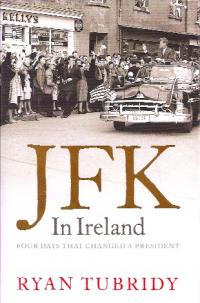
JFK in Ireland: Four days that changed a president
Ryan Tubridy
(Harper Collins, £20)
ISBN 978000731759
In June 1963 John F. Kennedy became the first US president to pay an official state visit to the Republic of Ireland. Other presidents have done so since, but none to the same effect. Kennedy’s four-day visit was a seminal event. The visit of the first Catholic Irish-American president had an impact that went far beyond a courtesy call. In Galway Cathedral there is a mosaic of the Crucifixion flanked by images of Patrick Pearse and JFK. And amongst the more striking motifs of twentieth-century Ireland are images of the Sacred Heart on which were emblazoned pictures of both Christ and Kennedy.
John F. Kennedy is one of the great symbols of the twentieth century, both as the embodiment of hope and as the lost leader struck down in his prime. For an Irish audience his story carried a more specific resonance. What this entailed was outlined at the start of Tubridy’s fascinating documentary: Kennedy’s visit encapsulated a narrative that began with his great-grandparents emigrating during the Great Famine and culminated in what the Irish Independent described as ‘the last point of integration into American life’—the presidency. Kennedy had visited Ireland twice previously. His presidential visit was the last stop on a European tour that was intended to highlight US support for western European allies in the shadow of the Soviet Union (it was on this trip that he famously claimed ‘Ich bin ein Berliner’). But the ever pragmatic Seán Lemass had discreetly lobbied for a presidential visit to Ireland, and consequently it became the last stop on Kennedy’s tour. Some regarded it as a sentimental indulgence, for Kennedy had a genuine interest in his Irish ancestry. But he visited an Ireland that was undergoing enormous changes, as it emerged from a stagnant and demoralising
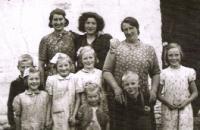
Photograph, taken by JFK himself on his first visit to Ireland in 1947, of Mary Ryan (right) and family at the ancestral homestead in Dunganstown, Co. Wexford. (Patrick Grennan)
post-war depression: the sight of JFK on Irish soil was perhaps the greatest of validations. The visit could also symbolise Ireland’s welcome back to the western fold after the contentious neutrality of the Emergency.
A number of interviewees spelled out the significance of the visit with considerable aplomb: Gearoid Ó Tuathaigh, Diarmaid Ferriter, Colm Toibin, Kennedy’s sister (and former US ambassador) Jean Kennedy-Smith, and his speechwriter Ted Sorenson (both of whom accompanied him to Ireland). And then there was Tubridy himself, whose venture into Irish history had been met with both publicity and begrudgery. He acquitted himself very well here. Tubridy presented this extremely well-produced documentary in a shrewd and professional manner; crucially, he remained in the background as his
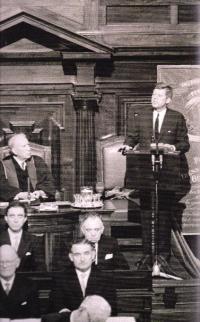
Leinster House—‘does not inspire the brightest of ideas’. Dev was unimpressed by JFK’s quote of Lord Edward Fitzgerald’s observation on his family home in an otherwise sycophantic speech to the Oireachtas. (Bettman/Corbis)
subject took centre stage. This impressive documentary made excellent use of a vast array of contemporary footage, and it gave one a very strong sense of Kennedy’s almost roguish charm: he received rapturous welcomes across the country, most especially in New Ross, whence his Wexford ancestors had emigrated.
From a US perspective, images of delighted crowds could do no harm with an election looming, despite Ireland’s strategic insignificance. But that insignificance ensured that one glaring issue was strenuously avoided: partition. According to Thomas J. Kiernan, the Irish ambassador to the US, Kennedy was ‘more British than Irish’ and would act accordingly. He spent more time in Ireland than in the UK during this visit, but ultimately the UK was the more significant ally, and he was not inclined to ruffle British feathers. But he was not inclined to offend his hosts either—at least, not deliberately. A comment in his almost sycophantic speech to the Oireachtas was suppressed by an unimpressed Eamon de Valera (Kennedy had quoted Lord Edward Fitzgerald’s observation that his family home, Leinster House, ‘does not inspire the brightest of ideas’). On the other hand, the same speech deliberately contained a quotation from James Joyce—an oblique comment on Ireland’s censorship regime. But such things went unnoticed amidst the rapture of a visit that culminated in an assurance that one day JFK would return. The moment passed, but it was captured in this very assured documentary, which turned out to be a pleasant surprise.
It is a pity, then, that the same cannot be said of Tubridy’s accompanying book. While lavishly produced, his JFK in Ireland is little more than a dutiful but dull chronicle of the minutiae of Kennedy’s visit. Admittedly it could never have the immediacy of the documentary, but the book feels rushed and sloppy; here Tubridy’s grasp of history is
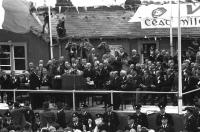
He received rapturous welcomes across the country, most especially in New Ross, whence his Wexford ancestors had emigrated. (RTÉ Stills Library)
disconcertingly shaky—partition did not lead ‘directly’ to the civil war (p. 18); the description of Henry Grattan as an ‘Irish freedom campaigner’ (p. 196) smacks of journalese—and he adopts a rose-tinted and breathless view of the Kennedys that all too often feels like padding. Having presented a very good documentary, Tubridy wrote a very disappointing book.
The darker side of JFK was touched upon by the BBC documentary. According to Andrew Marr, the manner by which Kennedy got to the White House apparently encapsulates ‘the making of modern politics’. The race for the Democratic nomination in 1960 saw the unashamed deployment of machine politics and smear tactics in the service of an exceptionally well-funded and telegenic candidate (who was also
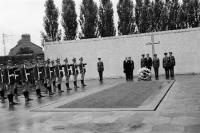
JFK honouring the graves of the 1916 leaders at Arbour Hill. So impressive were the Irish cadets who officiated there that his widow Jackie requested that they officiate at her husband’s graveside five months later. (RTÉ Stills Library)
accused of electoral fraud). Kennedy’s gift for rhetoric helped to overcome the tedium of detail. How ground-breaking all of this was is debatable, but it provided a useful corrective to more romantic views of ‘Camelot’. Unlike Tubridy, however, Marr forgot that the subject is more important than the presenter. His insufferably pompous presentation ruined what was potentially an excellent documentary.
Tubridy left the last word to Ted Sorenson (who died very recently), as his recollection of the aftermath of the twentieth century’s most famed assassination left him visibly affected over four decades later. Sorensen quoted Thomas Davis’s Lament for the death of Eoghan Ruadh O’Neill, a panegyric to a lost leader which, ironically, he had read whilst preparing for Kennedy’s visit to Ireland. But this was not the only coda. Kennedy had visited the graves of the 1916 leaders in Arbour Hill and was impressed with the Irish cadets who officiated there. In an unprecedented diplomatic move, his widow Jackie requested that they officiate at her husband’s graveside—a poignant testament to the fact that whether or not JFK cared about his Irish heritage for much of his life he had undoubtedly come to do so by the time of his death. HI
















